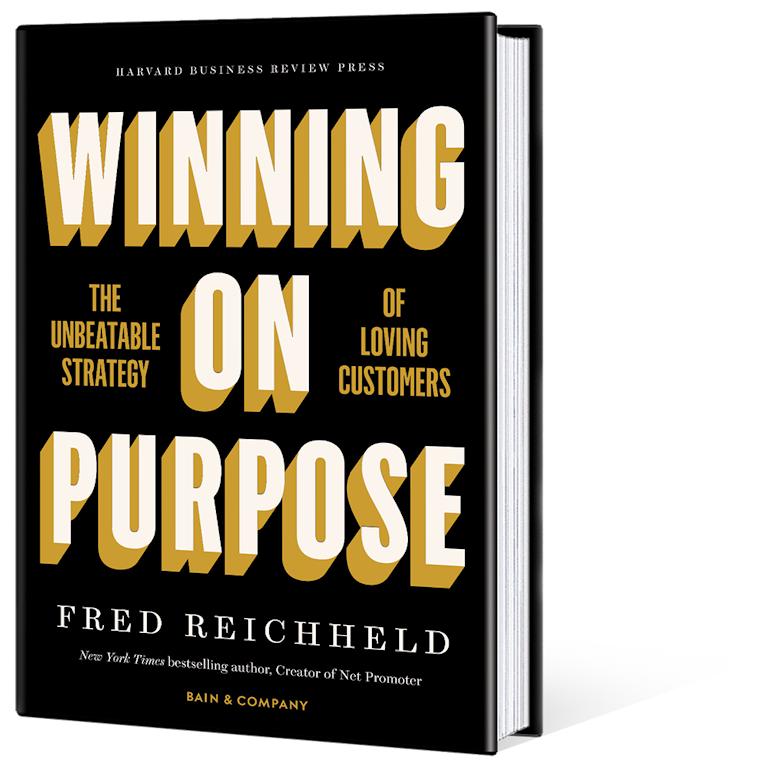
This article originally appeared on LinkedIn.
It made the news recently that Tim Cook, CEO of Apple, had cashed in a restricted stock grant worth $751 million. According to the SEC filing, the grant dates from 2011 and was mostly earned by longevity. Some 22% of the grant—1,120,000 shares—was based on Apple’s performance.
The benchmark used to judge that performance was the most popular one in the field of executive compensation, according to data-tracker Equilar: relative total shareholder return (TSR). To determine Cook’s bonus, Apple’s TSR was compared to that of other companies in the S&P 500 from August 25, 2018, through August 24, 2021.

Winning on Purpose: The Unbeatable Strategy of Loving Customers
This new book by Fred Reichheld, Darci Darnell, and Maureen Burns demonstrates that great leaders embrace a higher purpose to win, and Net Promoter® shines as their guiding star.
The technology giant’s return over that period was 192%, a performance that bested all but 12 of its peers. That was more than enough to earn Cook the entire grant. Under its terms, a TSR anywhere in the top third of the companies in the S&P 500 entitled him to the full grant. If Apple had been in the middle third, he would have earned half. In the bottom third, zero.
Apple’s board compensation committee might consider a couple of tweaks to this formula that, as we see it, would more closely align executive and investor interests going forward.
First, it seems to us that delivering TSR below the market average creates no real value for shareholders, since they could have achieved that return by investing in a diversified market index fund—average return with no single-company risk. Executive bonuses should be “in the money” only when they generate TSR above the average—and pay out the maximum bonus when TSR reaches the 90th percentile, a mark Apple easily surpassed in the period covered by this payout.

Customer Love Quiz
Learn how customer-centric your organization is today and receive practical suggestions for how to move forward on the path.
Second, to ensure that executives continue to put customer interests first as the company expands, we recommend that Apple find a way to link executive compensation to customer love.
Tim Cook almost certainly would have qualified for a maximum payout under these revised rules as well. Apple has long been a Net Promoter ScoreSM standout, and it’s clear that Cook and the rest of Apple management already care deeply about customers. Apple is the standard others look to, so making changes that align its future leaders’ objectives with the interests of customers and long-term investors would have broad influence.
A focus on stock performance and profits often works at cross purposes with customer focus, as our colleague Rob Markey noted in a feature for Harvard Business Review about properly valuing customers. He writes: “The true purpose of a business, Peter Drucker said, is to create and keep customers. Most managers understand this, but few behave as if they do. Under relentless earnings pressure, they often feel cornered, obliged to produce quick profits by compromising product quality, trimming services, imposing onerous fees, and otherwise shortchanging their customers. This short-termism erodes loyalty, reducing the value customers create for the firm.”
Including customers in the math of executive compensation would start with a benchmark that is consistently calculated across companies (“apples to apples,” as it were). For accuracy, it should be developed through a double-blind process and track appropriately large sample sizes.
One way to do that would be to include Net Promoter Score, or something similar, in pay calculation. At one time, we expected that large accounting firms, recognizing the critical asset that customers are, would develop an audit-worthy methodology for reporting such a score. So far they have not, maybe because companies, regulators, and investors have yet to demand it.
To fill that gap and provide reliable NPS® benchmark data, Bain & Company launched NPS Prism. It gathers quarterly Net Promoter feedback for every episode along a company’s customer journey. There are many challenges to properly developing a clear measure like this—from survey technique to the best timing for a request. One thing we have learned is that if you want reliable benchmark scores, you must engage a third party that has the deep expertise to do it right and consistently. Accepting self-reported information from companies won’t get you where you want to be.
There remains work to do. There are industries and regions of the world that Prism does not yet cover, but the effort to create comparable and valid measures of customer data is a worthy cause. Executive compensation is just one important area that would benefit from it. Financial results alone cannot tell us when a firm has enriched the lives of its customers. Running businesses primarily on financial results will eventually lead companies to treat profits as purpose—when customer love is the only purpose that can sustain winning outcomes.

